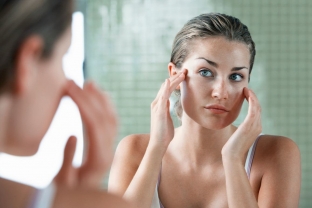The more a woman knows about her skin, its features and preferences, the easier it is to cope with the task of daily care. Usually the skin on the face is divided into 3 types: dry, oily and combination. But, it is also worth noting that there is also sensitive skin that requires special care and ordinary cosmetics are not always suitable for it. Sensitive skin can also be of 2 types: genetically inherited from parents and acquired. In these cases, it is necessary to distinguish between care for sensitive skin, which worries a woman from birth, and acquired. Consider care features & nbsp; sensitive skin on the face, as well as a list of harmful components for the skin that are part of cosmetics, from which it becomes even more problematic.
Why the skin becomes sensitive: genetic and acquired types
According to statistics, only 12% of women inherit sensitive skin, in all other cases – it is an acquired problem under the influence of many factors. care for sensitive skin.
Hypersensitivity of the skin responds with frequent redness, itching, rash, burning even to simple environmental factors: wind, rain, snow. Such manifestations may be the result of the use of poor-quality materials for applying makeup or a response to an irritating factor (component) that is part of the cosmetics. Do not forget about the health factor: if the body suffers from the influence of chronic ailments, the skin also reacts to internal stimuli.
The skin becomes sensitive when just one of the three protective barriers is broken. If the cover is not protected, bacteria and viruses can easily enter the body and multiply on the skin, irritating it.
Read also: Three ways to clean your face at home
Three protective barriers on the skin that stand in the way of the reproduction of harmful bacteria:
- The stratum corneum prevents excessive loss of moisture through the skin, in case of violation of this barrier, the skin becomes dry, prone to rashes and dryness.
- The work of the sebaceous glands involves the production of sebum, which covers the skin, forming another layer of lipid mantle (oily film) – prevents the growth of bacteria, softens the skin, retaining moisture.
- The work of the sweat glands is necessary to maintain the acid-base barrier and the balance of harmful and beneficial bacteria on the surface of the skin.
How to care for sensitive skin: a list of harmful ingredients
For sensitive skin, excessive passion for cleansing procedures or the use of various components for the preparation of masks is unacceptable. Skin that is prone to rash and irritation should be cleansed once a day – in the evening and in the morning use micellar water or simply wash your face without using a cleanser. In addition, for washing it is best to use soft milk, which will not greatly irritate the epidermis. Also, the use of scrub and peeling procedures should be minimized – 1-2 times a month. Scrub ingredients should be chosen based on the softness of the impact, so as not to injure already irritated areas.
Remember that the skin on the face cannot be sensitive 24 hours a day. Therefore, if the redness or rash does not go away after applying the cosmetic, you should be examined for allergies.
Irritation on the skin after the influence of cosmetics or wind disappears in an hour or two. The rash or redness will increase and grow if the allergy is not treated in time.
Read also: How to protect problem skin with acne from UV light
Also, sensitive skin is usually damaged by certain irritants – ingredients that brands often use to make facials. When purchasing a cleanser, eye shadow, or skin cream, check for harmful ingredients that can increase facial irritation.
"Black list" of components included in cosmetics that can harm sensitive skin:
- Shea butter (shea butter) – does not always have a positive effect on the skin, especially if you are allergic to nuts. In addition, the frequent use of this oil can lead to the accumulation of sebum on the surface of the skin and the growth of bacteria and fungi. And the more abundantly the skin is covered with this oil, the more irritation appears as a response to oversaturation with fat.
- Parabens – preservatives that destroy the protective mantle on the skin, so carefully check the composition of the cosmetic product.
- Triclosan – mostly present in antibacterial soap or face wash. If sterility borders on rash and redness, it is better not to use soap with this component. In addition to harmful bacteria, beneficial substances that maintain water balance are removed from the skin.
- Phthalates (diethyl phthalate and dibutyl phthalate) – carcinogens found in nail polishes. These components can provoke the appearance of eczema, nail defects, allergies.
- Retinoids – components that are found in anti-aging creams. Irritation on the skin when using a cream with retinoids can occur due to increased sensitivity to the sun and increased dryness of the skin in winter. It is better to use such creams in autumn or spring, and then with a very small dose in the composition of the product.

Read also: Herbal washing: beauty recipes for your skin
Proper care of sensitive skin can make it categorized as just dry or combination. Increased attention to the composition of the cosmetic product will provide the skin with a flow of only useful and necessary substances and protect it from negative effects. Be guided by your inner feelings when using any cosmetic product. For sensitive skin, natural products should be as carefully selected as any other. Eliminate foods and personal hygiene products that can cause allergies so as not to provoke skin irritation. Also keep in mind that sensitivity can increase if you are constantly nervous, abuse bad habits and eat wrong.






Add a comment